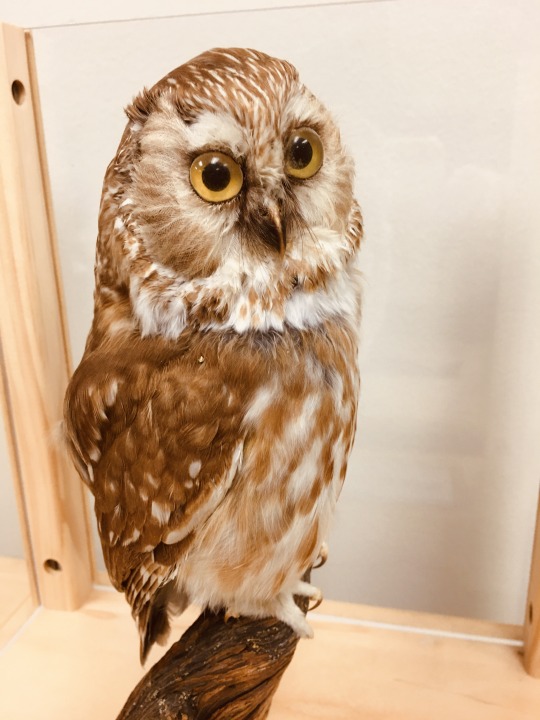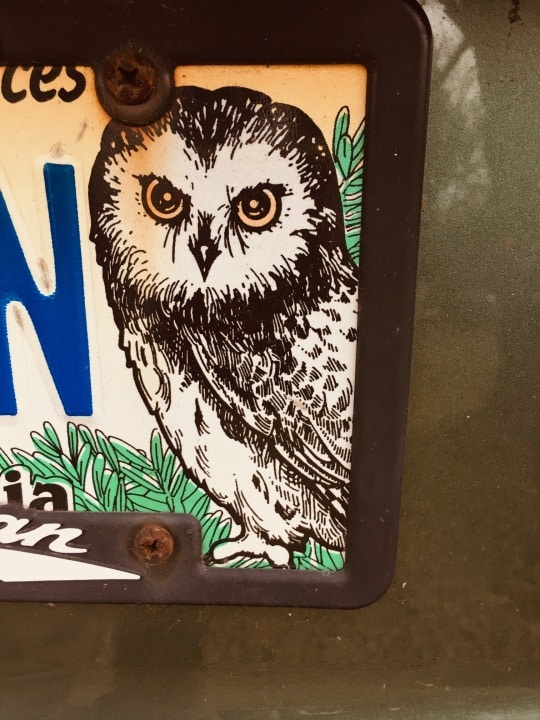Northern Saw-whet Owls have a reputation for showing-up in surprising places. The late November news that one of these small predators accompanied a 75-foot Norway spruce on a 200 mile journey from Oneonta, New York, where the 11-ton tree was cut, to Mid-town Manhattan, where the massive evergreen was installed in a place of honor at Rockefeller Center, fits the species’ profile.
The 8-inch high birds, whose common name reflects the resemblance of one of their calls to the sound of a saw being sharpened with a whet stone, are the smallest owl found in the mid-Appalachian region. As recently as 30 years ago infrequent sightings of the owls were interpreted as evidence of the species’ decline. That assumption began to change in the 1990s with the establishment of Project Owlnet, an ongoing multi-state field study that now consists of more than 100 owl migration banding sites where on late nights every fall researchers rely on recordings of the reclusive bird’s too-too-too breeding call to lure and temporarily capture owls in mist nets. These nocturnal labors have documented healthy populations of the owls in suitable habitats, although this good news is leavened with cautions that the species’ association with higher elevation forests could make it susceptible to the effects of climate change in the coming decades.
The individual owl getting attention as a holiday tree stow-away was driven back upstate to a wildlife rehabilitation facility in the town of Saugerties, where caregivers reported the bird seemed unharmed by its odyssey. The owl, according to reports, was quickly approaching condition for release back into the wild. Back in New York City, however, a counter explanation has developed for how and when the owl arrived in the Rockefeller Center Tree. According to some interested parties, the owl could have been in the city ahead of the tree’s arrival, and sought refuge in the big spruce before it was unloaded.

A relatively recent experience leads me to view this explanation as within the realm of possibility. One fall day four years ago, while I was rolling a cart bearing owl taxidermy mounts into a basement classroom, a visitor stopped me by pointing directly at the smallest bird in the set. “Might I have seen this bird last week?” he asked excitedly. “At a bus stop?? On the Northside???” He then explained how the owl had been perched motionless at eye-level within leafy bushes beside a bus shelter, and that, “The owl was still there when I got on my bus.”
The museum basement, I later learned, has a direct claim to an even more remarkable sighting of species now being widely celebrated for cuteness and resilience on social media. In Birds of Western Pennsylvania, the encyclopedic 1940 volume written by the museum’s then Curator of Ornithology, W.E. Clyde Todd, the account for Northern Saw-whet Owl includes this note:
“A curious instance of a young bird found alive in one of the basement storerooms of the Carnegie Museum in June, 1927, was duplicated in July, 1932. There must have been a nesting pair in the immediate vicinity, although one would scarcely expect this owl within the city limits.”

For the past seven years, proof of the owl’s seasonal movements through the Pittsburgh area has been found in Sewickley Heights Borough Park where Bob Mulvihill, ornithologist at the National Aviary, has operated a Project Owlnet banding station during the late fall. Information about this important local research can be found on the National Aviary website.
To see a video of a Northern Saw-whet Owl recently banded at Powdermill Nature Reserve, please visit the museum’s TikTok.
Patrick McShea works in the Education and Visitor Experience department of Carnegie Museum of Natural History. Museum employees are encouraged to blog about their unique experiences and knowledge gained from working at the museum.
